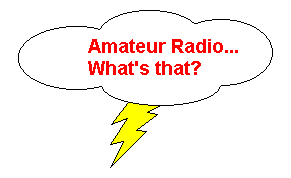

by Rob L. Dey, KA2BEO, June 1997
Imagine for a moment that it’s a warm summer day. You’re sitting down, relaxed in your own backyard, and on a tiny hand-held radio, you begin a "live", personal conversation with the commanding astronaut aboard the Space Shuttle, Columbia. Sound improbable? Maybe impossible? Well, an exciting hobby, called Amateur Radio, actually makes this possible. Amateur Radio operators, or "Hams" as they’re called, can talk to astronauts and cosmonauts in outer space from anywhere on earth. Everyday, hams help people and make new friends around the world from their homes, cars, and outdoors.
Ham Radio operators make it a point to be helpful in emergencies too. When a disaster strikes, and all other communications fail, hams step in to help families contact their loved ones. Sometimes, they even save lives by relaying critical information during a crisis. In January of ‘97, the crash of ComAir flight 3272 called for almost 30 hams to help out and provide emergency management communications around the Ida, Michigan area.
Most Ham Radio enthusiasts like to experiment with leading-edge technologies. For example, some hams actually communicate with other hams by bouncing their signal off of the moon or off of ionized meteor trails. Others enjoy designing, building, and using their own equipment and antennas. Some hams like to collect and restore antique radios and old telegraph equipment. And, many hams are active in their local Amateur Radio clubs, which are closely involved with the community, especially during public service events such as parades and walk-a-thons.
A great thing about this hobby is that anyone can be an Amateur Radio operator. Hams range in age from under 6 to over 100. An entire family can have fun making friends world-wide, as they learn the culture and history of other countries. Kids, as well as adults, can benefit from this hobby, by getting involved with geography and math. Also, using Morse code enhances spelling abilities.
Besides Morse code and voice, hams can communicate with each other by using their computers. As a ham, you can use your radio equipment to do things like: remotely make phone calls, communicate using satellites, create your own TV station, talk to ham-astronauts in space, participate in operating contests, and collect operating awards. With the addition of a personal computer, you can: transfer e-mail messages, data files, and graphic images over the airwaves. You can operate radio-teletype, or monitor the current locations of hams on a "live" map using GPS technology.
So, how can you become a ham? Well, America’s hams are licensed by the Federal Communications Commission, or FCC. You can get a license simply, by passing a 55-question exam on basic electricity and some general radio-operating rules. The cost of this test is less than six dollars, and examinations are given locally, a few times per month.
One of the largest ham organizations in the US is the American Radio Relay League, or ARRL, which started in 1914. If you’re interested, or you have a family member that might be interested in getting started in Ham Radio, you can contact the American Radio Relay League in Newington, Connecticut by calling 1-800-32-NEW-HAM or by visiting their Web site at www.arrl.org.
